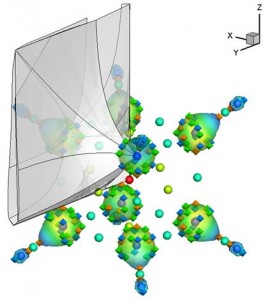The Materials Genome Initiative
 Just over two years ago, President Obama announced the Materials Genome Initiative. The name is sort of silly—materials don’t have genes—but the ideas behind the initiative are significant. In short, the goal is to “discover, develop, manufacture, and deploy advanced materials at twice the speed that is possible today”. To do this, we must develop a wide range of analytical techniques that will allow materials to be designed from “first principles” analyses.
Just over two years ago, President Obama announced the Materials Genome Initiative. The name is sort of silly—materials don’t have genes—but the ideas behind the initiative are significant. In short, the goal is to “discover, develop, manufacture, and deploy advanced materials at twice the speed that is possible today”. To do this, we must develop a wide range of analytical techniques that will allow materials to be designed from “first principles” analyses.
At a recent aerospace conference they referred to this as the “atoms to airplanes” initiative.
In the world of chemistry and material science, “first principles” means quantum mechanics. Software has been available for some time to compute the electron wave functions from the material composition (the type and location of the atoms in the material). Loosely speaking, these wave functions give the probability that a specific electron will be at a given location in the material at any given time. Added together, they give the electron charge density – the probability that any electron will be found at a given point in the material at any given time. Together, the wave functions and electronic charge density are the electronic structure of the material.
Scientists know that the properties of materials, and chemicals for that matter, are a function of the electronics structure of the material. Unfortunately, techniques to compute the bulk properties of materials from the electronic structure have proven difficult to develop. This is, perhaps, the biggest obstacle to the success of the Materials Genome Project. If you can’t compute the bulk properties (modulus of elasticity, etc.) from the material composition (the type and location of atoms in the material), you can’t go from “atoms to airplanes” (or bridges, or buildings, or …).
For the last seven years, Tecplot has been collaborating with a group at Colorado School of Mines, led by Professor Mark Eberhart, to develop software that can compute the bulk properties of the materials from the electronic structure.
The technique is based on the idea that materials with similar arrangements and properties of “chemical bonds” within the material will have similar bulk properties. Chemical bonds are not usually a concept that is applied to materials—primarily because they are so difficult to identify. Our software identifies these chemical bonds using the topology of the electronic charge density. The software, code-named “ChemBond”, has already shown success in the analysis and design of new steel alloys.

Tim Wilson

Scott Imlay
Tim Wilson from Mark’s group at the Colorado School of Mines joined us over the summer to help complete ChemBond. This is an exciting milestone for us at Tecplot. If we can create a more robust ChemBond we could help fill a critical gap in the Materials Genome Initiative. In a very real way, we could help change the world! Stay tuned!




